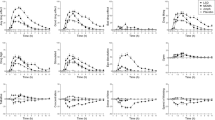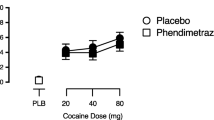Abstract
Rationale
Most reports of the effects of methamphetamine and 3,4-methylenedioxymethamphetamine (MDMA) on speech have been anecdotal.
Objectives
The current study used a within-participant design to assess the effects of methamphetamine and MDMA on speech.
Materials and methods
Eleven recreational users of amphetamines completed this inpatient, within-participant, double-blind study, during which they received placebo, methamphetamine (20, 40 mg), and MDMA (100 mg) on separate days. Following drug administration, study participants described movies viewed the previous evening and completed mood scales.
Results
Methamphetamine increased quantity of speech, fluency, and self-ratings of talkativeness and alertness, while it decreased the average duration of nonjuncture unfilled pauses. MDMA decreased fluency and increased self-ratings of inability to concentrate. To determine if methamphetamine- and MDMA-related effects were perceptible, undergraduates listened to the participants’ movie descriptions and rated their coherence and the speaker’s mood. Following methamphetamine, descriptions were judged to be more coherent and focused than they were following MDMA.
Conclusions
Methamphetamine improved verbal fluency and MDMA adversely affected fluency. This pattern of effects is consistent with the effects of these drugs on functioning in other cognitive domains. In general, methamphetamine effects on speech were inconsistent with effects popularly attributed to this drug, while MDMA-related effects were in agreement with some anecdotal reports and discordant with others.



Similar content being viewed by others
References
Carter BDM, Carter CS (2005) Amphetamine improves cognitive function in medicated individuals with schizophrenia and in healthy volunteers. Schizophr Res 77:43–58
Cami J, Farre M, Mas M, Roset PN, Poudevida S, Mas A, San L, de la Torre R (2000) Human pharmacology of 3, 4-methylenedioxymethamphetamine (“ecstasy”): psychomotor performance and subjective effects. J Clin Psychopharmacol 20:455–466
Cho AK, Melega WP, Kuczenski R, Segal DS (2001) Relevance of pharmacokinetic parameters in animal models of methamphetamine abuse. Synapse 39:161–166
Cohen J, MacWhinney B, Flatt M, Provost J (1993) PsyScope: an interactive graphical system for designing and controlling experiments in the psychology laboratory using Macintosh computers. Behav Res Meth Instr Comp 25:257–271
Comer SD, Haney M, Foltin RW, Fischman MW (1996) Amphetamine self-administration by humans: modulation by contingencies associated with task performance. Psychopharmacology (Berl) 127:39–46
Comer SD, Hart CL, Ward AS, Haney M, Foltin RW, Fischman MW (2001) Effects of repeated oral methamphetamine administration in humans. Psychopharmacology 155:397–404
Gouzoulis-Mayfrank E, Hermle L (1998) Are the “entactogens” a distinct psychoactive substance class? The contribution of human experimental studies to the classification of MDMA and other chemically related methylenedioxyamphetamine derivatives. Heffter Rev Psych Res 1:46–51
Greer G, Tolbert R (1986) Subjective reports of the effects of MDMA in a clinical setting. J Psychoact Drugs 18:319–327
Greer GR, Tolbert R (1998) A method of conducting therapeutic sessions with MDMA. J Psychoact Drugs 30:371–379
Griffiths RR, Stitzer M, Corker K, Bigelow G, Liebson I (1977) Drug-produced changes in human social behavior: facilitation by d-amphetamine. Pharmacol Biochem Behav 7:365–372
Grosjean F, Lane H (1976) How the listener integrates the components of speaking rate. J Exp Psychol Hum Percept Perform 4:538–543
Guenther FH (2006) Cortical interactions underlying the production of speech sounds. J Commun Disord 39:350–365
Halkitis PN, Fischgrund BN, Parsons JT (2005) Explanations for methamphetamine use among gay and bisexual men in New York City. Subst Use Misuse 40:1331–1345
Hart CL, Ward AS, Haney M, Foltin RW, Fischman MW (2001) Methamphetamine self-administration by humans. Psychopharmacology 157:75–81
Hart CL, Haney M, Foltin RW, Fischman MW (2002) Effects of the NMDA antagonist memantine on human methamphetamine discrimination. Psychopharmacology 164:376–384
Hart CL, Ward AS, Haney M, Nasser J, Foltin RW (2003) Methamphetamine attenuates disruptions in performance and mood during simulated night shift work. Psychopharmacology 169:42–51
Hart CL, Gunderson EW, Perez A, Kirkpatrick MG, Thurmond A, Comer SD, Foltin RW (2008) Acute physiological and behavioral effects of intranasal methamphetamine in humans. Neuropsychopharmacology 33:1847–1855
Heishman SJ, Stitzer ML (1989) Effect of d-amphetamine secobarbital and marijuana on choice behavior: social versus nonsocial options. Psychopharmacology (Berl) 99:156–162
Higgins ST, Stitzer ML (1988) Time allocation in a concurrent schedule of social interaction and monetary reinforcement: effects of d-amphetamine. Pharmacol Biochem Behav 31:227–231
Higgins ST, Stitzer ML (1989) Monologue speech: effects of d-amphetamine secobarbital and diazepam. Pharmacol Biochem Behav 34:609–618
Hollien H, DeJong G, Martin CA (1998) Production of intoxication states by actors: Perception by lay listeners. J Forensic Sci 43:1153–1162
Jaffe J, Dahlberg CC, Luria J, Chorosh J (1973) Effects of LSD-25 and dextroamphetamine on speech rhythms in psychotherapy dialogues. Biol Psychiatry 6:93–96
Johanson CE, Kilbey M, Gatchalian K, Tancer M (2006) Discriminative stimulus effects of 3, 4-methylenedioxymethamphetamine (MDMA) in humans trained to discriminate among d-amphetamine, meta-chlorophenylpiperazine and placebo. Drug Alcohol Depend 81:27–36
Johnson BA, Roache JD, Ait-Daoud N, Wallace C, Wells LT, Wang Y (2005) Effects of isradipine on methamphetamine-induced changes in attentional and perceptual-motor skills of cognition. Psychopharmacology (Berl) 178:296–302
Jones HE, Garrett BE, Griffiths RR (2001) Reinforcing effects of oral cocaine: contextual determinants. Psychopharmacology (Berl) 154:143–152
Kirkpatrick MG, Metcalfe J, Greene MJ, Hart CL (2008) Effects of intranasal methamphetamine on metacognition of agency. Psychopharmacology 197:137–144
Kelly BC, Parsons JT, Wells BE (2006) Prevalence and predictors of club drug use among club-going young adults in New York City. J Urban Health 83:884–895
Klingholz F, Penning R, Liebhart E (1988) Recognition of low-level alcohol intoxication from speech signal. J Acoust Soc Am 84:929–935
Kuypers KP, Ramaekers JG (2005) Transient memory impairment after acute dose of 75 mg 34-methylene-dioxymethamphetamine. J Psychopharmacol 19:633–639
Liechti ME, Gamma A, Vollenweider FX (2001) Gender differences in the subjective effects of MDMA. Psychopharmacology (Berl) 154:161–168
Logan BK (1996) Methamphetamine and driving impairment. J Forensic Sci 41:457–464
Maguire GA, Gottschalk LA, Riley GD, Franklin DL, Bechtel RJ, Ashurst J (1999) Stuttering: neuropsychiatric features measured by content analysis of speech and the effect of risperidone on stuttering severity. Compr Psychiatry 40:308–314
Martin WR, Sloan JW, Sapira JD, Jasinski DR (1971) Physiologic, subjective, and behavioral effects of amphetamine, methamphetamine, ephedrine, phenmetrazine, and methylphenidate in man. Clin Pharmacol Ther 12:245–258
McGee SM, McGee DN, McGee MB (2004) Spontaneous intracerebral hemorrhage related to methamphetamine abuse: autopsy findings and clinical correlation. Am J Forensic Med Pathol 25:334–337
Natale M, Dahlberg CC, Jaffe J (1979) The effect of psychotomimetics on therapist–patient matching of speech “rhythms”. J Commun Disord 12:45–52
Patterson DE, Braverman SE, Belandres PV (1997) Speech dysfunction due to trazodone–fluoxetine combination in traumatic brain injury. Brain Injury 11:287–291
Pisoni DB, Martin CS (1989) Effects of alcohol on the acoustic–phonetic properties of speech: perceptual and acoustic analyses. Alcohol Clin Exp Res 13:577–587
Pisoni DB Yuchtman M Hathaway N (1986) Effects of alcohol on the acoustic–phonetic properties of speech In: Alcohol accidents and injuries. Society of Automotive Engineers, Pittsburgh, PA, special paper P-173, 131–150
Rodgers J, Buchanan T, Pearson C, Parrott AC, Ling J, Hefferman TM, Scholey AB (2006) Differential experiences of the psychobiological sequelae of ecstasy use: quantitative and qualitative data from an internet study. J Psychopharmacol 20:437–446
Rothman RB, Baumann MH, Dersch CM, Romero DV, Rice KC, Carroll FI, Partilla JS (2001) Amphetamine-type central nervous system stimulants release norepinephrine more potently than they release dopamine and serotonin. Synapse 39:32–41
SAMHSA (2008) Tips for teens: the truth about club drugs. http://ncadisamhsagov/govpubs/phd852/
Semple SJ, Patterson TL, Grant I (2003) Binge use of methamphetamine among HIV-positive men who have sex with men: pilot data and HIV prevention implications AIDS. Educ Prev 15:133–147
Sevak RJ, Stoops WW, Hays LR, Rush CR (2009) Discriminative stimulus and subject-rated effects of methamphetamine d-amphetamine methylphenidate and triazolam in methamphetamine-trained humans. J Pharmacol Exp Ther 328:1007–1010
Silber BY, Croft RJ, Papafotiou K, Stough C (2006) The acute effects of d-amphetamine and methamphetamine on attention and psychomotor performance. Psychopharmacology 187:154–169
Silverman K, Kirby KC, Griffiths RR (1994) Modulation of drug reinforcement by behavioral requirements following drug ingestion. Psychopharmacology (Berl) 114:243–247
Stitzer ML, Griffiths RR, Liebson I (1978) Effects of d-amphetamine on speaking in isolated humans. Pharmacol Biochem Behav 9:57–63
Stoops WW, Lile JA, Fillmore MT, Glaser PE, Rush CR (2005a) Reinforcing effects of methylphenidate: influence of dose and behavioral demands following drug administration. Psychopharmacology (Berl) 177:349–355
Stoops WW, Lile JA, Fillmore MT, Glaser PE, Rush CR (2005b) Reinforcing effects of modafinil: influence of dose and behavioral demands following drug administration. Psychopharmacology (Berl) 182:186–193
Tancer M, Johanson CE (2003) Reinforcing subjective and physiological effects of MDMA in humans: a comparison with d-amphetamine and mCPP. Drug Alcohol Depend 72:33–44
Tancer M, Johanson CE (2007) The effects of fluoxetine on the subjective and physiological effects of 3, 4-methylenedioxymethamphetamine (MDMA) in humans. Psychopharmacology 189:565–573
Vollenweider FX, Gamma A, Liechti M, Huber T (1998) Psychological and cardiovascular effects and short-term sequelae of MDMA (“ecstasy”) in MDMA-naive healthy volunteers. Neuropsychopharmacology 19:241–251
Acknowledgements
This research was supported by a grant from NIDA (Hart, R01 DA03746) and served as Gina Marrone’s undergraduate honor’s thesis project at Barnard College. We gratefully acknowledge Isabel Cajori Jay, Chantal Sowemimo-Coker, and Christina Perry for their help collecting listener-rated data. We also thank Drs. Stephen Heishman, David Epstein, and Peter Balsam for their comments on earlier versions of the manuscript.
Author information
Authors and Affiliations
Corresponding author
Rights and permissions
About this article
Cite this article
Marrone, G.F., Pardo, J.S., Krauss, R.M. et al. Amphetamine analogs methamphetamine and 3,4-methylenedioxymethamphetamine (MDMA) differentially affect speech. Psychopharmacology 208, 169–177 (2010). https://doi.org/10.1007/s00213-009-1715-0
Received:
Accepted:
Published:
Issue Date:
DOI: https://doi.org/10.1007/s00213-009-1715-0




